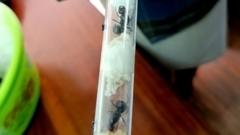During a brief lapse in supervision, the artwork Rothko's Grey, Orange on Maroon, No. 8, valued at €50 million, was scratched. Museum representatives are currently reviewing treatment options and have assured that the damages are superficial. The incident highlights the vulnerabilities of unvarnished modern paintings and the broader implications for museums displaying valuable artworks.
Child Accidentally Damages €50 Million Rothko Artwork in Rotterdam Museum

Child Accidentally Damages €50 Million Rothko Artwork in Rotterdam Museum
A child has caused significant damage to a valuable painting by Mark Rothko at the Museum Boijmans Van Beuningen in Rotterdam, prompting concerns over the protection of modern art.
While restoration efforts are poised to commence, questions loom about the accountability for damages and the effectiveness of insurance coverage for museums hosting interactive exhibitions.
In an unfortunate incident, a child inflicted damage on a highly valuable Rothko painting at a museum in Rotterdam, haunting the art world with concerns over children's interactions with significant artworks. The renowned abstract painter's masterpiece, Grey, Orange on Maroon, No. 8, was scratched while on display in the museum's Depot during an unguarded moment. Museum Boijmans Van Beuningen is currently evaluating its next steps regarding restoration efforts for the painting, which experts estimate is worth around €50 million.
According to museum officials, the scratches are deemed "superficial" and primarily located in the piece's lower section. Conservation experts have been consulted, both domestically and internationally, to determine the most effective treatment solutions. The museum spokesperson emphasized their hope that the painting will be restored to a state where it can eventually be exhibited again.
Art conservators, including Sophie McAloone from the Fine Art Restoration Company, noted that modern paintings like Rothko's are particularly vulnerable to damage due to their unvarnished nature and complex material compositions. Damage to the upper paint layers can undermine the overall visual experience of such pieces. This incident raises crucial questions about museum policies as institutions like the British Museum consider making previously archived pieces more publicly accessible.
Marketing expert Jonny Helm highlighted the repercussions this incident could have on UK institutions exploring similar display strategies, emphasizing the complexities surrounding Rothko's techniques in restoration. It is essential for conservators to document the extent of the damage and utilize successful historical treatments as guides for their efforts.
This is not the first time a Rothko has faced such adversity; in 2012, a Rothko piece was deliberately vandalized by Wlodzimierz Umaniec, leading to extensive restoration work and legal repercussions. Insurance specialist Rachel Myrtle noted that art insurance typically covers accidental damages inflicted by visitors, although specifics can vary. The Museum Boijmans Van Beuningen has previously allocated liability to visitors for damage caused in its premises.
The occurrence echoes broader challenges faced by museums regarding the handling of art, particularly as incidents involving unintentional damages due to visitors are no rarity. For example, a four-year-old child recently shattered an ancient jar in an Israeli museum, a situation that was met with understanding towards the family.
As restoration efforts begin for Rothko's Grey, Orange on Maroon, No. 8, the art world continues to grapple with the fine balance between accessibility and the safeguarding of art treasures.
In an unfortunate incident, a child inflicted damage on a highly valuable Rothko painting at a museum in Rotterdam, haunting the art world with concerns over children's interactions with significant artworks. The renowned abstract painter's masterpiece, Grey, Orange on Maroon, No. 8, was scratched while on display in the museum's Depot during an unguarded moment. Museum Boijmans Van Beuningen is currently evaluating its next steps regarding restoration efforts for the painting, which experts estimate is worth around €50 million.
According to museum officials, the scratches are deemed "superficial" and primarily located in the piece's lower section. Conservation experts have been consulted, both domestically and internationally, to determine the most effective treatment solutions. The museum spokesperson emphasized their hope that the painting will be restored to a state where it can eventually be exhibited again.
Art conservators, including Sophie McAloone from the Fine Art Restoration Company, noted that modern paintings like Rothko's are particularly vulnerable to damage due to their unvarnished nature and complex material compositions. Damage to the upper paint layers can undermine the overall visual experience of such pieces. This incident raises crucial questions about museum policies as institutions like the British Museum consider making previously archived pieces more publicly accessible.
Marketing expert Jonny Helm highlighted the repercussions this incident could have on UK institutions exploring similar display strategies, emphasizing the complexities surrounding Rothko's techniques in restoration. It is essential for conservators to document the extent of the damage and utilize successful historical treatments as guides for their efforts.
This is not the first time a Rothko has faced such adversity; in 2012, a Rothko piece was deliberately vandalized by Wlodzimierz Umaniec, leading to extensive restoration work and legal repercussions. Insurance specialist Rachel Myrtle noted that art insurance typically covers accidental damages inflicted by visitors, although specifics can vary. The Museum Boijmans Van Beuningen has previously allocated liability to visitors for damage caused in its premises.
The occurrence echoes broader challenges faced by museums regarding the handling of art, particularly as incidents involving unintentional damages due to visitors are no rarity. For example, a four-year-old child recently shattered an ancient jar in an Israeli museum, a situation that was met with understanding towards the family.
As restoration efforts begin for Rothko's Grey, Orange on Maroon, No. 8, the art world continues to grapple with the fine balance between accessibility and the safeguarding of art treasures.




















